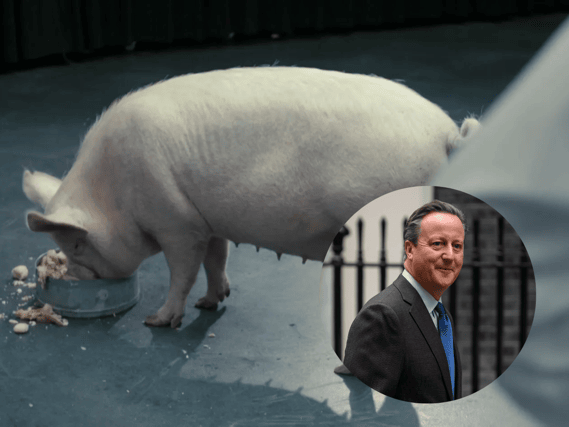As Lord Cameron returns to cabinet, now is an ideal time to revisit Black Mirror’s ‘The National Anthem’


As I watched the unthinkable happen during Rishi Sunak’s cabinet reshuffle, which included a return to parliament for one-time prime minister Lord Cameron, two thoughts crossed my mind. One: what on earth is going in at Number 10 that has prompted the return of a political character who ‘ditched’ his premiership role after losing the Brexit referendum and the political shenanigans we found ourselves in since his departure?
The second thing that crossed my mind was that I need to revisit the first season of Charlie Brooker’s techno-horror anthology ‘Black Mirror,’ and in particular, a certain episode focusing on a British prime minister, their standing with the voting public and a pig. That episode I talk about, of course, is ‘The National Anthem,’ the very first episode of the series that aired in December 2011.
Advertisement
Hide AdAdvertisement
Hide AdFor those who were unfamiliar with the episode, or to recap for those with a shortish memory, ‘The National Anthem’ posed a problem to British Prime Minister Michael Callow, played brilliantly by Rory Kinnear: either have sex with a pig live on the national television, or the beloved Princess Susannah, who has been kidnapped, will be killed. It’s a moral quandary for the prime minister; does he degrade himself for the safety of the Royal family member and, with it, curry favour from voters ahead of the next general election, or does he spare his family the indignation of having sex with a pig on national television and incur the wrath of the public for failing to save the princess through this selfless act?
The episode weighs up the options, as the kidnappers show their hand by leaving a part of the Princess’s body as a threat to follow through with the demand, after an attempt to use technology to replace Callow with a ready, willing and surprisingly eager porn actor. As time ticks away, the pressure is on Callow and ultimately (spoilers ahead) - he decides his political career and standing with the public is worth the brief public humiliation. After all, how much political capital could he gain by f**king a pig and saving the Princess?
At the dissolution of his marriage and family life though, as the episode comes to its conclusion, with the revelation that the entire ordeal was merely a form of culture jamming by a renowned British artist and, while everyone was busy watching the Michael Callow debase himself, the Princess was actually let go prior to the deed being undertaken. An allegory by Brooker about how obsessed with were with salaciousness that we miss the bigger picture - the Princess was never in trouble, and Callow didn’t need to have intercourse with that pig. We were all part of a larger art installation about how shallow we are when it comes to scandal.
That episode was released in 2011. Fast forward to 2015 and those revelations about Lord Cameron in what has been referred to now as ‘Piggate.’
Advertisement
Hide AdAdvertisement
Hide AdWhat was Piggate?
What was Piggate, or now Lord Cameron is back in office, what is Piggate? That would be the revelation that the current Foreign Secretary engaged in a bizarre initiation ritual during his university days. The anecdote, detailed in Michael Ashcroft and Isabel Oakeshott's unauthorised biography ‘Call Me Dave,’ alleges that Cameron, as part of an initiation for the Piers Gaveston Society at Oxford University, inserted his genitalia into a dead pig's mouth.
Published in the Daily Mail in September 2015, the anecdote attributed the story to an anonymous Member of Parliament who was supposedly a contemporary of Cameron at Oxford. The book's authors failed to obtain corroborating evidence or a response from the purported owner of a photograph of the alleged incident.
Downing Street responded by refusing to dignify the claim with a response, and Cameron dismissed it as "utter nonsense." The media coined the term "Piggate," and social media erupted with hashtags like #piggate and #hameron. Despite the attention, no substantial evidence supporting the anecdote emerged.
The reaction to "Piggate" ranged from public mockery to political commentary. Cameron himself joked about it during a public appearance, expressing disbelief at the absurdity of the allegation - but many people drew comparisons to what Cameron was accused of undertaking and what the fictional Prime Minister did in ‘The National Anthem’ due to how eerily similar both situations seemed to be.
Advertisement
Hide AdAdvertisement
Hide AdThere was one big difference though; despite Callow undertaking the task to curry voter favour which he initially did and further his career, by proxy saving a life that didn’t need saving in the end. Cameron’s reason for putting his MP in the mouth of a pig’s head wasn’t for the good of the nation - just his standing with his elite Oxfordite companions. While the nation benefitted from Callow’s actions, the only person who benefitted in Cameron’s case was Cameron himself. Well, that, and a few hundred sales of ‘Call Me Dave.’
Where can I watch the Black Mirror episode, ‘The National Anthem?’
‘The National Anthem,’ the first episode of ‘Black Mirror’ Season 1, can be streamed now through Netflix
Comment Guidelines
National World encourages reader discussion on our stories. User feedback, insights and back-and-forth exchanges add a rich layer of context to reporting. Please review our Community Guidelines before commenting.
